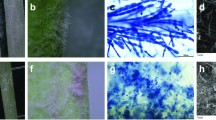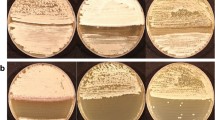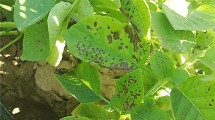Abstract
Large patch disease, caused by Rhizoctonia solani AG2-2, is the most devastating disease in Zoysiagrass (Zoysia japonica). Current large patch disease control strategies rely primarily upon the use of chemical pesticides. Streptomyces sp. S8 is known to possess exceptional antagonistic properties that could potentially suppress the large patch pathogen found at turfgrass plantations. This study aims to demonstrate the feasibility of using the strain as a biological control mechanism. Sequencing of the S8 strain genome revealed a valinomycin biosynthesis gene cluster. This cluster is composed of the vlm1 and vlm2 genes, which are known to produce antifungal compounds. In order to verify this finding for the large patch pathogen, a valinomycin biosynthesis knockout mutant was created via the CRISPR/Cas9 system. The mutant lost antifungal activity against the large patch pathogen. Consequently, it is anticipated that eco-friendly microbial preparations derived from the S8 strain can be utilized to biologically control large patch disease.






Similar content being viewed by others
References
Asano T, Senda M, Suga H, Kageyama K (2010) Development of multiplex PCR to detect five Pythium species related to turfgrass diseases. J Phytopathol 158:609–615
Aziz RK, Bartels D, Best AA, DeJongh M, Disz T, Edwards RA, Meyer F (2008) The RAST server: rapid annotations using subsystems technology. BMC Genomics 9:75
Beard JB (1972) Turfgrass: science and culture. Prentice-Hall, Englewood Cliffs
Bérdy J (2012) Thoughts and facts about antibiotics: where we are now and where we are heading. J Antibiot 65:385–395
Blin K, Medema MH, Kazempour D, Fischbach MA, Breitling R, Takano E, Weber T (2013) antiSMASH 2.0—a versatile platform for genome mining of secondary metabolite producers. Nucleic Acids Res 41:W204–W212
Breukink E, Wiedemann I, van Kraaij C, Kuipers OP, Sahl HG, de Kruijff B (1999) Use of the cell wall precursor lipid II by a pore-forming peptide antibiotic. Science 286:2361–2364
Cheng YQ (2006) Deciphering the biosynthetic codes for the potent anti-SARS-coV cyclodepsipeptide valinomycin in Streptomyces tsusimaensis ATCC 15141. Chem Bio Chem 7:471–477
Čihák M, Kameník Z, Šmídová K, Bergman N, Benada O, Kofroňová O, Petříčková K, Bobek J (2017) Secondary metabolites produced during the germination of Streptomyces coelicolor. Front Microbiol 13:2495
Cobb RE, Wang Y, Zhao H (2014) High-efficiency multiplex genome editing of Streptomyces species using an engineered CRISPR/Cas system. ACS Synth Biol 4:723–728
Couch HB, Lucas LT, Haygood RA (1990) The nature and control of Rhizoctonia blight. Golf Course Manag 58:49–58
Delauney AJ, Verma DP (1993) Proline biosynthesis and osmoregulation in plants. Plant J 4:215–223
Engelke MC, Murray JJ, Yeam DY (1983) Distribution, collection and use of zoysiagrass in the Far East, part II. Agronomy Abstract, pp. 123–125
Gerhardson B (2002) Biological substitutes for pesticides. Trends Biotechnol 20:338–343
Graham J, Marshall B, Squire G (2003) Genetic differentiation over a spatial environmental gradient in wild Rubus ideaus populations. New Phytol 157:667–675
Hwang YS, Choi JS (1999) Effect of mowing interval, aeration, and fertility level on the turf quality and growth of zoysiagrass (Zoysia japonica Steud.). Kor Turfgrass Sci 13:79–90
Islam MR, Jeong YT, Ryu YJ, Song CH, Lee YS (2009) Isolation, identification and optimal culture conditions of Streptomyces albidoflavus C247 producing antifungal agents against Rhizoctonia solani AG2-2. Mycobiology 37:114–120
Kieser T (2000) Practical Streptomyces genetics. John Innes Foundation, Norwich
Lee DW, Lee SM, Kim DS, Choi TH, Chang TH (2012) Application of paraffin oil for control of large patch on Zoysia japonica. Asian J Turfgrass Sci 26:17–23
Lee SM, Kim DS, Lee K, Lee C, Lee DW (2013) Antibiotic properties of Helicosporium sp. KCTC 0635BP to Rhizoctonia solani AG2-2 IV. Weed Turfgrass Sci 2:202–206
Lee JH, Min GY, Jeon CW, Choi SM, Shim GY, Kwak YS (2015a) Investigation of fungicide response of Streptomyces spp. isolated from rhizosphere in zoysiagrass. Kor J Pestic Sci 19:54–63
Lee JH, Min GY, Shim GY, Jeon CW, Kwak YS (2015b) Physiological characteristics of Actinomycetes isolated from turfgrass rhizosphere. Weed Turfgrass Sci 4:348–359
Lee JH, Min GY, Shim GY, Jeon CW, Choi SM, Han JJ, Kwak YS (2015c) Soil microbial community analysis in large patch (Rhizoctonia solani AG2-2 IV). Weed Turfgrass Sci 4:124–128
Livak KJ, Schmittgen TD (2001) Analysis of relative gene expression data using real-time quantitative PCR and the 2−ΔΔCT method. Methods 25:402–408
Matter AM, Hoot SB, Anderson PD, Neves SS, Cheng YQ (2009) Valinomycin biosynthetic gene cluster in Streptomyces: conservation, ecology and evolution. PLoS ONE 4:e7194
McCarty LB, Gregg MF, Toler JE, Camberato JJ, Hill HS (2005) Minimizing thatch and mat development in a newly seeded creeping bentgrass golf green. Crop Sci 45:1529–1535
Miller CS, Handley KM, Wrighton KC, Frischkorn KR, Thomas BC, Banfield JF (2013) Short-read assembly of full-length 16S amplicons reveals bacterial diversity in subsurface sediments. PLoS ONE 8:e56018
Monakhova OF, Chernyad'ev II (2002) Protective role of kartolin-4 in wheat plants exposed to soil draught. Appl Biochem Microbiol 38:373–380
Nawani NN, Kapadnis BP, Das AD, Rao AS, Mahajan SK (2002) Purification and characterization of a thermophilic and acidophilic chitinase from Microbispora sp. V2. J Appl Microbiol 93:965–975
Obasa K, Fry J, Kennelly M (2012) Susceptibility of zoysiagrass germplasm to large patch caused by Rhizoctonia solani. HortSci 47:1252–1256
Pan X, Richardson MD, Deng S, Kremer RJ, English JT, Mihail JD, Xiong X (2017) Effect of organic amendment and cultural practice on large patch occurrence and soil microbial community. Crop Sci 57:2263–2272
Park CN, Lee JM, Lee D, Kim BS (2008) Antifungal activity of valinomycin, a peptide antibiotic produced by Streptomyces sp. Strain M10 antagonistic to Botrytis cinerea. J Microbiol Biotechnol 18:880–884
Patton AJ, Schwartz BM, Kenworthy KE (2017) Zoysiagrass (Zoysia spp.) history, utilization, and improvement in the United States: a review. Crop Sci 57:S-37–S-72
Raaijmakers JM, Weller DM (1998) Natural plant protection by 2, 4-diacetylphloroglucinol-producing Pseudomonas spp. in take-all decline soils. Mol Plant Microbe Interact 11:144–152
Smiley RW, Dernoeden PH, Clarke BB (2005) Compendium of turfgrass diseases, 3rd edn. American Phytopathological Society, St. Paul
Smirnoff N, Cumbes QJ (1989) Hydroxyl radical scavenging activity of compatible solutes. Phytochemistry 28:1057–1060
Song CH, Islam M, Chang TH, Lee YS (2012) Isolation and identification of antagonistic bacteria for biological control of large patch disease of zoysiagrass caused by Rhizoctonia solani AG2-2 (IV). Asian J Turfgrass Sci 26:8–16
Suslov TV (1982) Role of root-colonizing bacteria in plant growth. In: Mount MS, Lacy GH (eds) Prokariotes phytopathogenic. Academic Press, London, pp 187–223
van Dessel W, van Mellaert L, Geukens N, Lammertyn E, Anné J (2004) Isolation of high quality RNA from Streptomyces. J Microbial Methods 58:135–137
Welbaum GE, Sturz AV, Dong Z, Nowak J (2004) Managing soil microorganisms to improve productivity of agro-ecosystems. Crit Rev Plant Sci 23:175–193
Acknowledgement
This work was supported by the Technology Development Program for Agriculture and Forestry, Ministry for Food, Agriculture, Forestry and Fisheries, Republic of Korea (Project No. 315004-5).
Author information
Authors and Affiliations
Corresponding author
Additional information
Publisher's Note
Springer Nature remains neutral with regard to jurisdictional claims in published maps and institutional affiliations.
Electronic supplementary material
Below is the link to the electronic supplementary material.
Rights and permissions
About this article
Cite this article
Jeon, CW., Kim, DR. & Kwak, YS. Valinomycin, produced by Streptomyces sp. S8, a key antifungal metabolite in large patch disease suppressiveness. World J Microbiol Biotechnol 35, 128 (2019). https://doi.org/10.1007/s11274-019-2704-z
Received:
Accepted:
Published:
DOI: https://doi.org/10.1007/s11274-019-2704-z




